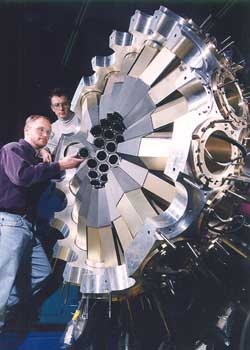Researchers anticipate possibilities for RIA’s ‘big science’ projects
By Steve KoppesNews Office
 The Gammasphere, the world’s most sensitive gamma-ray detector, is among the many resources at Argonne National Laboratory that could enhance research at the Rare Isotope Accelerator. RIA is the proposed $1 billion facility to produce and study short-lived atomic nuclei.  Mark Kedzie of Argonne National Laboratory's Physics Division examines a module of superconducting resonators that accelerate particles at Argonne's ATLAS facility. RIA would incorporate this technology. | |
When it comes to shuffling atoms into new combinations and configurations, scientists have been playing with an incomplete deck of cards. The atomic nuclei that are readily available for such work number fewer than 300. But isotopes of these nuclei, many of which no longer exist in nature and which blink out of existence a fraction of a second after their birth, number in the thousands.
With capabilities unmatched anywhere else in the world, the proposed Rare Isotope Accelerator would help scientists obtain some of these thousands of missing cards. Studying the generation of energy in stars, testing new ideas about the fundamental forces of nature that govern the universe, and creating new treatments in nuclear medicine are just a few projects that scientists would carry out with RIA.
The U.S. Department of Energy/National Science Foundation Nuclear Science Advisory Committee has named RIA its highest priority for new construction. Within the next few months, the University will formally propose that the DOE build RIA at Argonne National Laboratory, which the University operates. The University’s competition for the $1 billion facility is Michigan State University. Should Congress approve the project, the first funds could be appropriated as early as 2007.
“This certainly qualifies as big science,” said Robert Rosner, Argonne’s Chief Scientist and the William Wrather Distinguished Service Professor in Astronomy & Astrophysics. “Why would you want to do this? Well, there are many reasons,” said Rosner, who last year presented the scientific case for RIA to John Marburger III, President Bush’s science adviser.
“RIA is capable of producing copious quantities of unusual radioisotopes,” Rosner said. “That has obvious applications in a whole variety of fields ranging from fundamental nuclear physics to nuclear medicine to non-destructive testing of materials to materials science in general.”
RIA also could play a vital role in training greater numbers of nuclear physicists to provide important support roles in nuclear medicine, metallurgy, and other segments of industry, government and the scientific community.
“Over the last two or three decades, the United States has suffered a serious decrease in highly qualified scientists working in nuclear physics,” Rosner said. “In physics, traditionally a field doesn’t thrive when there is a paucity of new data. There was a long period in nuclear physics when no new, large experiments were built. That era, thank goodness, is over.”
In the last 10 years, the DOE has built new nuclear physics accelerators at Brookhaven National Laboratory and the Thomas Jefferson National Accelerator Facility. Each of those accelerators occupies a different niche of nuclear physics research, as would RIA. “RIA would be the third leg in this tripod of key nuclear physics accelerators, one of whose aims is to reinvigorate the field of nuclear physics in the United States,” Rosner said.
Increasing the number of scientists working in the field is not just an expertise issue, but also a safety issue. Rosner noted that the DOE is responsible for maintaining the nation’s stockpile of nuclear weapons.
“Imagine the United States in 20 years without a sufficient pool of competent nuclear physicists, and we have the nuclear stockpile still lying around. That’s a scary thought,” he said.
One of the deep connections between RIA and University scientists is in the area of astrophysics: RIA will help astrophysicists answer one of the biggest questions in all of science: what fate ultimately awaits the universe? In previous work, astrophysicists have used a certain category of exploding stars as measuring devices, which they call “standard candles.” Their measurements indicate that the expansion of the universe is accelerating.
An accelerating universe opens the possibility that one day in the unimaginably distant future, the galaxies will fly so far apart as to become invisible to one another. Depending on the nature of the force causing the acceleration, it could even mean that one day all matter, including stars, planets and even atoms, will eventually be torn apart.
But there is a complication with the measurements because they are based on the assumption that distant supernovae shine with the same characteristic intensity as nearby supernovae—that they are in fact standard candles. Because scientists can measure the distance to nearby supernovae with two different techniques, they can validate the assumption that the supernovae are standard candles for these objects.
Unfortunately, for distant supernovae, “we don’t have independent distance measurements,” Rosner said. But these supernovae are the ones scientists have used to posit their theory of an accelerating universe.
To resolve this issue, “you need to have an understanding of the fundamental physics that explains why these objects are standard candles,” Rosner said. RIA could help provide this understanding by allowing scientists to glimpse the nuclear reactions that take place inside exploding stars.
But first, the accelerator has to be built. “Congress, of course, is the key player here,” Rosner said.
![[Chronicle]](/images/sidebar_header_oct06.gif)